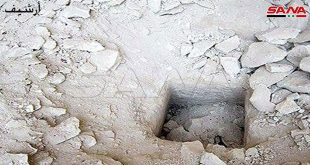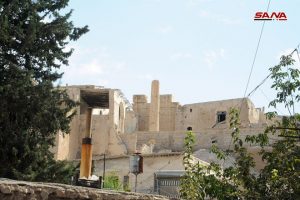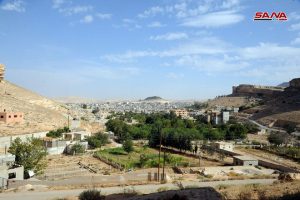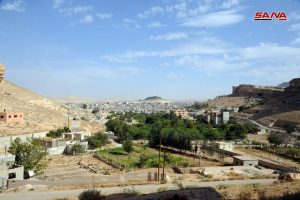Damascus, SANA – Yabroud city has attracted vast interest from researchers and historians throughout time due to its historic and archaeological monuments that vary between valleys, temples, caves and tombs, some of which date back to more than 300 B.C.
SANA camera visited the city and toured its historic landmarks.
In an exclusive interview to SANA, Director of Damascus Countryside Antiquities Department Jihad Abu Kahla spoke about the most important archaeological sites in Yabroud, most notably the “Iskafta Valley”, where the German archaeologist Alfred Rust made many important pre-historical findings between 1930 and 1933.
He added that the valley includes six havens and a cave, noting that the first haven is the most important one due to the unearthed archaeological artifacts which date back to different historical periods.
Abu Kahla pointed out that Rust’s findings motivated a US expedition from Columbia University headed by archaeologist Ralph Solecki and his wife to conduct excavation works in Yabroud in the period between 1963 and 1965.
“Fossilized animal bones and charcoal remains dating back to more than 300,000 years ago were found at the site,” said Kahla.
He added that royal tombs including 17 headstones from the Middle Bronze Age were discovered in the northern part of the valley, indicating that archaeologists Ali Abu Assaf and Qasem Tweir from the General Directorate of Antiquities and Museums took part in the excavation works carried out at the site in 1964 and 1965.
Abu Kahla said that Yabroud civilization was mentioned in the pottery tablets of Mesopotamia in the 1st century B.C. and Ptolemy’s book in the 2nd century A.D. which underlines the city’s historical significance.
Other important archaeological sites include Al-Hawa Temple, dating back to the Canaanite and Aramaic periods, and the Canaanite Temple of al-Shams (the Sun), transformed to Jupiter Temple in the Roman period and later became “Constantine and Helena Cathedral” in the 4th century A.D.
According to Kahla, 18 tombs and several caves, dating back to Roman period, were found on the rocky slopes of Qarina Valley on the from Yabroud to Ras al-Ain.
Located in the heart of Yabroud city, Tel al-Qab’a archaeological site which was occupied by a garrison of Roman soldiers still exist, in addition to St. Nicholas Cathedral, al-Sayeda Zeinab Mosque and several Islamic landmarks.
The terrorist war waged against Syria inflicted severe damage to the whole city, said Abu Kahla, adding that terrorist groups carried out illegal excavations, destroyed most of these archaeological sites and looted their contents.
He underlined the directorate’s efforts in cooperation with other concerned governmental bodies to restore terror-damaged sites.
R. Raslan/Ghossoun
 Syrian Arab News Agency S A N A
Syrian Arab News Agency S A N A





















